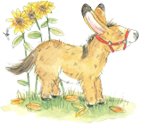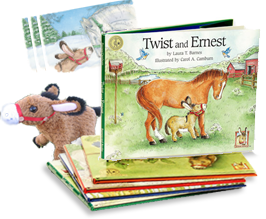Lesson Plans
Enjoy incorporating the following suggested activities into your classroom. Adapt accordingly for grades K – 4.
Suggested Materials
- Ernest Series® books
- Pictures of various characters in the story for students to color (print out from our Fun Stuff page)
- Art supplies including paper, scissors, crayons, markers, glue, tape, large chart paper
- Story Map
- Audio of Old MacDonald song
General Comprehension Activities
- Write ideas for a book to follow in the series.
- Create a play from the books. Make costumes and scenery for the play .
- Create a puppet show.
- Create a barnyard scene in the classroom.
- Have students retell the story in their own words.
- Have students predict a different ending.
- Allow students to recreate the story using their own writing and artwork
- Have students write about a past experience that corresponds with something in the Ernest Series® books.
- Have students draw their favorite scene from the story.
- Compare and contrast Ernest with the other characters in the books.
- Have students add new words they’ve learned from the stories to an existing vocabulary wall.
- Discuss beginning, middle and end sequencing.
- Discuss Who, What, Where, When and How.
Old MacDonald
Recommended for: Grades 1 – 2
- Show students the cover of a book in the Ernest Series®.
- Ask students what they see.
- Where else have they seen these animals?
- What are they? What do they have in common? What do they think the animals will do in the story?
- Read the story to the students.
- Ask what main characters were in the story. What are their names?
- Put students into small groups, each with the goal of creating a specific piece of a barnyard scene such as a barn, fence, grass, pond, etc.
- Students choose an animal to draw/color after being told about the barnyard scene that they are going to create.
- After the barnyard scene is complete, students add their animal pictures.
- Students take turns telling parts of the story to the rest of the class using the scenery to point out ideas and animals.
- Conclusion: Students sing “Old MacDonald,” adapting it to the sounds made by animals from the story.
Character Identification
Recommended for: Grades 2 – 3
- Show the cover of one of the books in the series.
- Have students predict what might happen in the book.
- Can they guess who the main character is?
- Where might the story take place?
- Read and familiarize students with the story.
- Have students determine the following:
- Who is the main character? Have students write his name in the center of a large piece of colored paper.
- What is he like? Have students write descriptions under the name. Draw a box around the name and descriptions.
- Who else is important in the story? Have students write these names evenly spaced around the box.
- How does the main character feel about them/vice versa? Write responses on arrows running away from the center box toward each other box.
- Conclusion: Ask the students to write how they felt about the main character at the beginning of the story and at the end.
- Can the students infer what might happen in the additional books in the Ernest Series®?
Incorporate Story Web
Recommended for: Grade 3
- Introduce students to a visual Story Web including setting, characters, problem, events and ending.
- Read one of the stories from the Ernest Series®.
- Have students work with a partner or group to discuss the story and complete a Story Web handout. Students can reread the story within their group if necessary.
- Discuss the Story Web with the entire class.
- Conclusion: Ask students to share their favorite part of the story. Relate to where it would be on the Story Web..
Students as Authors
Recommended for: Grades 3 – 4
- Announce to the class that they have been chosen to become a group of authors hired to write a new book in the Ernest Series®.
- Review several books in the Ernest Series®.
- Create 2 – 4 web diagrams on chart paper, each one to be designated to a separate book in the series, plus one blank web for the new book that they are about to create.
- Create circles on each web diagram with Who, What, Where, When, How.
- Hang the web diagrams on the classroom wall.
- Fill in the information for the existing books in the Ernest Series®.
- As a group, discuss ideas for Who, What, Where, When, How for a new book.
- Use separate chart paper to discuss each section (sequencing) of their story – beginning (intro), middle (body) and end (conclusion).
- When all brainstorming for the new book is completed, hang blank chart paper next to each section of the story. They are ready for their first draft.
- Work as a class to begin writing their story using their web diagram and story sequencing charts. Encourage students to offer as many ideas as possible as this is only a rough draft and can be cleaned up later.
- Editing – break class into three groups. Each group should work on editing one part of the story (beginning, middle and end). Use a different color marker for all editing. Critique grammar, comprehension and the use of descriptives. Repeat this step several times until the class is satisfied with the results.
- When final draft is completed, have volunteers copy the story neatly on to clean chart paper and display pages around the room.
- Now that the story is finished, determine who is interested in illustrating their book, role playing parts of the story, creating visual effects (puppets, dioramas, clay animations, etc.) or performing something musical. Have students work in small groups to carry out these tasks.
- Conclusion: Display illustrations around the classroom alongside their writing. Have three students volunteer to read aloud the finished beginning, middle and end parts of the story.
Discuss the difficulties and achievements they faced as a team while creating a new book for the series. What was their favorite part of the process?
Option: Have the class write a letter to the author enclosing a copy of their new book in the Ernest Series®.
These lesson plans were compiled in part from ideas submitted by Janet Ciaccia, Diane M. Stanjev, Michael E. Yanny and Rhonda Hargraves from Holy Family College.






